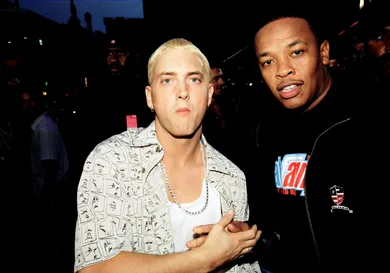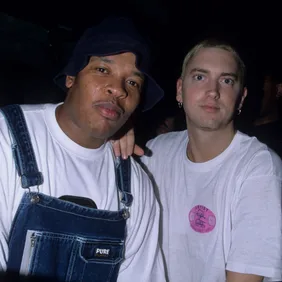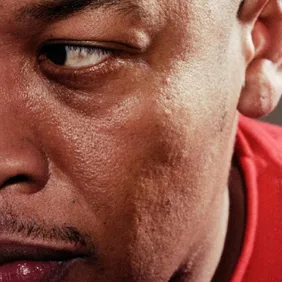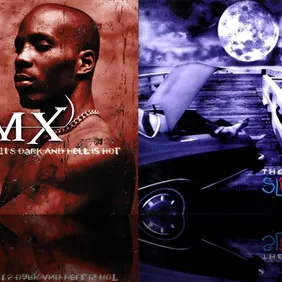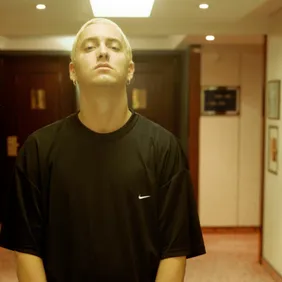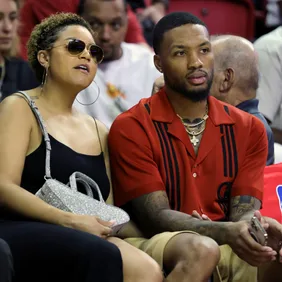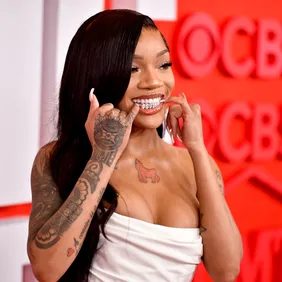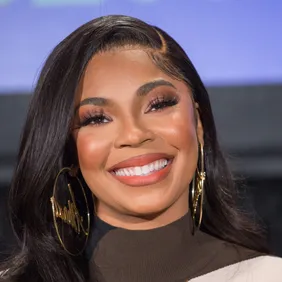The formative years found Dr. Dre and Eminem's musical chemistry in its developmental stages. In every effective partnership, the creative waters must be tested. HBO’s The Defiant One documents the origins of their partnership, revealing that Dr. Dre took a massive risk in signing the young battle-rapper from Detroit. Reflecting on his first time hearing Eminem during a listening session in Jimmy Iovine’s garage, Dre revealed that he was immediately captivated by Slim’s intensity. It didn’t take long for a meeting to be arranged.
“Eminem comes in in this bright yellow fuckin’ sweatsuit,” remembers Dre. “I’m like ‘man listen, I think this shit is fuckin’ incredible, and I’d like to work with you.” What followed was a spontaneous jam session at Dre’s home studio, during which the Doc queued up “My Name Is.” Em responded by blurting out the iconic chorus within seconds, sparking an epiphany in Dre. Though an unconventional partnership on paper, Em and Dre found themselves in a cycle of creative exploration, one that was forced to begin with unconditional trust.
At the onset of his career, Dre’s music never shied away from violence. His work with NWA and Death Row helped pioneer gangsta rap as we know it. The latter’s brand was built on menace, a quality Dre realized through his preference for minor-key production. The threat of gunplay was never far from Tha Row, with Suge Knight’s formidable shadow looming overhead. Curiously, Eminem’s debut album Infinite was a relatively tame affair, a few ax-swings removed from Slim Shady’s maniacal tendencies. Still, songs like the cult-classic “Hellbound” revealed Em’s inclinations toward the macabre, an obsession that would later be honed by Dre’s practiced hand. There’s something undeniably endearing about Dre reciting Slim’s opening “My Name Is” bars with wide-eyed excitement, laughing at Em’s increasingly vile absurdist comedy.
Though Dre’s circle cautioned him against sealing the deal, the Doctor remained adamant in his pursuits. Eventually, the powers that be relented, and Dre was given the green light to bring Eminem into the Aftermath fold. In hindsight, it’s easy to take their journey for granted. But to really understand what they built together, how their musical and stylistic directions have evolved over decades of collaboration, is an examination worth undertaking.
Kevin Mazur Archive/WireImage/Getty Images
DO YOU LIKE VIOLENCE
The first collaboration Dr. Dre and Eminem ever put to tape was “My Name Is.” Musically, the song spelled a departure for Dre, who drew the signature bassline from Labi Siffre's “I Got The…” Essentially a minimalist arrangement with ample space for Em to play, “My Name Is” was the first Dre beat that was genuinely playful. Like a child burning ants beneath a microscope. Paired with Em’s darker lyrics and mischievous cadence, the track played a pivotal role in shaping a foundation that would continue to evolve. Though Dre contributed a mere three tracks to Em’s 1999 classic The Slim Shady LP, each one captured a different level of Em’s insanity.
Their next single, “Guilty Conscience” continued the minimalist pattern. No stranger to the piano, the track stands among the first examples of Dre’s signature early-millennium sound; consider songs like Eve’s "What," G-Unit’s "Poppin Them Thangs" and 50 Cent’s "If I Can’t." More importantly, it marked the beginning of Dre and Em’s dynamic on wax, the most twisted teacher-student relationship since Stephen King’s Apt Pupil. Once again, Dre’s approach to producing for Em was minimalist, a single looping progression layered with cinematic strings. It’s hard to say who set the tone, but both men seemed to revel in the chaos while flipping the angel-devil archetype on its head. Last but certainly not least was “Role Models,” an eerie guitar-driven beat tailored for Eminem’s battle-rap instincts; not unnoticed is the subtle ambiance of bubbling water, heightening the immersion of Eminem’s opening promise.
After Slim Shady LP became a breakout success, Em once again found himself locked into the studio to work on Dr. Dre’s Chronic follow-up, 2001. Slim would go on to appear on two songs (two and a half if you count “The Watcher”), both of which featured a different sort of beat. Despite their tonal distinctions, “What’s The Difference” and “Forgot About Dre” were both ominous and cinematic, with the latter featuring an uncharacteristically rapid-fire drum arrangement. This up-tempo shift forced Dre and Em to spit double-time bars, uncharted territory for both parties. Another uniting link between both tracks is the sense of camaraderie, in which Em makes it clear he’ll ride for Dre, a fact that emboldens the veteran Doc; lest we forget, Eminem’s momentous rise blew a second wind into Dre’s sails, a reinvigoration both creatively and commercially.
The rise would only continue. The new millennium saw the release of Eminem’s sophomore studio album The Marshall Mathers LP, which featured an abundance of Dre beats. The seeds originally planted on Slim Shady LP blossomed into the next stage, with Dre digging deep to craft soundscapes appropriate for Slim’s increasingly deranged content. Together with Mel-Man, Dre further cemented Slim’s signature sound, providing melodic, carnivalesque loops that encapsulated Em’s raison d’etre. While undoubtedly violent in nature, Dre seemed cognisant of Slim’s tounge-in-cheek demeanor, thus imbuing his beats with a mischievous air. The full-scale horrorcore of Relapse was years away; on MMLP, Dre and Em were skewing closer to social commentary than conceptualization. And while once again sparse in nature, Dre knew exactly how to enhance Slim’s emotions through music. Consider the weary frustration of “I’m Back’s” guitar loop or the cutting bassline and pizzicato present in “Who Knew.” It’s the subtle touches.
James Devaney/WireImage/Getty Images
CURTAINS UP
As Eminem’s superstardom grew, so too did Dre’s inclination toward experimentation. With the basis of his new sound taking hold, Dre brought new elements into the mix for his work on D12’s Devil’s Night. Implementing shades of rock music on “Fight Music” and “Revelations,” Dre’s versatility provided new backdrops for Eminem’s increasingly venomous bars. Painted as a public enemy by politicians and protestors, Em’s misunderstood nature manifested into something beyond mere artistry. Unsolicited opinions about his life and his image became commonplace. The veneer of Marshall Mathers LP was beginning to crumble as desires to understand the man behind it intensified. The natural conclusion was The Eminem Show, a project some still define as Em’s magnum opus.
As the most personal album of his young career, Em opted to handle the bulk of the production himself. Still, Dre’s fingerprints were all over The Eminem Show; who do you think taught Eminem how to engineer, a skillset for which he would develop a passion. The three beats he did contribute once again carried pre-existing traditions, including “Business,” which played out like an antihero’s theme song. Another milestone was hit, in that Dre provided Eminem with his first diss track instrumental in “Say What You Say,” a back and forth warning shot at Jermaine Dupri and Canibus. Closing things out was “My Dads Gone Crazy,” further proof that Dre favored darker arrangements for his protege.
Art imitates life, and Em’s fourth album Encore arrived under misfortunate circumstances. Grappling with an increasingly dangerous addiction, the fallout of a volatile war with Murder Inc and Benzino, and an exhaustively growing celebrity, Em and Dre set the tone within the project’s opening moments, the haunting “Evil Deeds.” It’s curious to note that Encore featured more Dre beats than any existing project, the result of an unfortunate leak. “I remember four songs leaked and I had to go to L.A. and get Dre and record new ones,” explained Em. “I was in a room by myself writing songs in 25, 30 minutes because we had to get it done, and what came out was so goofy. That’s how I ended up making songs like 'Rain Man' and 'Big Weenie.'" The result of last-minute necessity, Encore found Dre once again bringing cartoon villainy to life; only this time, Em’s antagonist had simply borne one burden too many. Despite Dre bringing his A-game, there’s a sense of fatigue prevalent in Encore, one that imbues the project with a sense of gravitas given all that would transpire.
Ke.Mazur/Getty Images
SAME SONG AND DANCE
It would be five years before Eminem and Dr. Dre would reunite to work on an album as creative partners. Is it no surprise the dynamic duo would pick up where they left off? Released in 2009, Eminem’s Relapse would be the most Dre-heavy album of his career, as well as his darkest on a conceptual level. It was here in which the extent of Em and Dre’s trust for one another would be revealed. Some might have balked at the idea of Dr. Dre dusting off bagpipes to soundtrack a deranged and accented serial killer. The challenge was met, and Dre gave Eminem a truly haunting musical canvas over which he could play. Where previous beats flirted with the macabre, songs like “Same Song & Dance,” “Stay Wide Awake,” and “3 AM” dove face-first into horrorcore territory.
It might be surprising for either man to admit this, but Relapse features some of the most brilliant moments of their career. Seemingly united by a singular concept, Dre pulled no shortage of instruments from his toolkit, from the lullaby-esque music boxes to the piano, guitars to the aforementioned bagpipes. Musical throughlines between earlier works were created; “Taking My Ball” and “Ass Like That,” “Never Enough” and “Drop The Ball On Em,” “Business” and “Old Time’s Sake.” Em has never sounded more technically inspired than on Relapse, weaving together unprecedented flow schemes. All the while, that old sense of mischief remains a driving force, unchanged since it first emerged on “My Name Is.” Consider the age-old question answered: yes, they very much do like violence.
KMazur/WireImage/Getty Images
OLD TIME’S SAKE
Ten years removed from the release of Relapse, Eminem and Dr. Dre have once again entered the studio. That’s not to say their partnership has diminished, but it has taken somewhat of a backseat. Recovery featured a single Dre beat; Marshall Mathers LP 2, Revival, and Kamikaze had none. His presence was felt in a producorial sense, be it through his engineering prowess or his guidance in the sequencing process, but Em’s discography has been bereft of that classic Dre Sound for a minute. After all, when one reflects on Dr. Dre and Eminem, there are likely several adjectives that come to mind, none of which remain present in Em’s contemporary soundscapes -- except maybe “Framed,” which came from another west coast icon Fred Wreck. Even Compton’s penultimate “Medicine Man,” which marked Dre and Em’s last collaboration on wax, was laced by Dem Jointz & Focus - thus a deviation from their expected sound.
Perhaps things are about to change. Celebrated radio host Big Boy was privy to some new music from Dr. Dre and Eminem, a revelation he shared in mid-September. “Dr. Dre and Eminem, from what I heard,” teases Big Boy. “Amazing. They in the bag. I heard it. It wasn’t because Dr. Dre pressed play on it. What they’re coming with is fire. Fire. Brand new.” Though it’s not much to go on, the news remains monumental for a variety of reasons. With Dre and Em once again committed to making music as a collaborative partnership, it stands to reason that their established habits will re-emerge under a new light. It may very well spell a return to a more ominous aesthetic, one fans have been openly missing since Relapse settled nicely into its “cult classic” status.
All we can do is deal in assumptions and educated guesses. Yet the knowledge that Eminem and Dr. Dre are once again inspiring one another is enough to bring solace to any nostalgic rap fan. Should old habits indeed die hard, it feels fair to assume that a modern-day collaboration between Eminem and Dr. Dre will reinforce everything they’ve built together over the past twenty years. From awakening an innate sense of mischief to exploring the darkest corners of Eminem’s accented alter-ego, Slim and Dre have excelled in forging a truly irreplicable sound.
